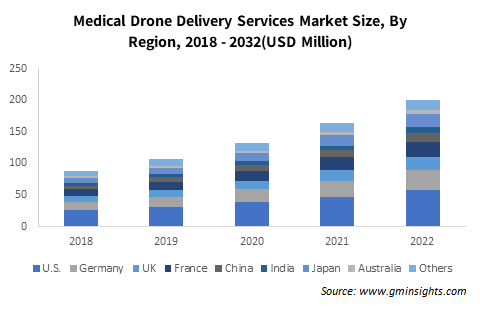Home > Healthcare > Medical Services > Medical Drone Delivery Services Market
Medical Drone Delivery Services Market Size
Medical Drone Delivery Services Market size exceeded a valuation of USD 200 million in 2022 and is projected to witness over 25% CAGR through 2032 driven by the notable advancements in drone technology.

Medical products are often stockpiled in urban centers and delivering them to remote villages that lack adequate road and rail links is costly and time-consuming. Under-developed nations have become key areas for the utilization of aerial drone technology in recent years and are also driving the advancement of drone designs while penetrating new markets for drone services in collaboration with private enterprises and other agencies. Underdeveloped regions, mainly in Africa, are forming partnerships to accelerate the development and usage of aerial drones, positively influencing the medical drone delivery services market.
Furthermore, prominent companies are focusing heavily on integrating cutting-edge technologies into existing medical drones. For instance, Wing, Alphabet's drone delivery startup, is developing bigger drones capable of handling heavier packages. Moreover, modern innovations support the storage of medical supplies, such as blood components, at the correct temperature, as well as the creation of ambulance drones capable of delivering defibrillators to emergency care providers. The Delft University of Technology in the Netherlands has created a prototype ambulance drone that has a cardiac defibrillator and a 2-way communication radio and video.
| Report Attributes | Details |
|---|---|
| Base Year: | 2022 |
| Market Size in 2022: | USD 200 Million |
| Forecast Period: | 2023 to 2032 |
| Forecast Period 2023 to 2032 CAGR: | 25.2% |
| 2032 Value Projection: | USD 1.8 Billion |
| Historical Data for: | 2018 to 2022 |
| No. of Pages: | 85 |
| Tables, Charts & Figures: | 79 |
| Segments covered: | Application, End-use, and Country |
| Growth Drivers: |
|
| Pitfalls & Challenges: |
|
Complications linked with the usage of medical drones may impede market expansion
The use of drones to carry medical supplies and services is constrained by varied factors, including short battery life, poor load capacity, and high cost of carriage, which may limit product uptake. Furthermore, uncertainties associated with the feasibility of these solutions compared to conventional land-based transportation services after considering the amortization costs as well as additional costs, such as those for drone training and certification for personnel, insurance, preventive maintenance, accidents, or failures. However, ongoing R&D efforts in the area of drone technology are likely to help manufacturers overcome this constraint.
Medical Drone Delivery Services Market Analysis

Based on application, the medical drone delivery services market share from the vaccination program segment is anticipated to grow at a 25.5% CAGR between 2023 and 2032 propelled by ongoing efforts by various establishments and massive investments toward promoting the use of medical drones to supply timely vaccines during emergency situations and in remote areas. In September 2021, VillageReach, a non-profit global health organization, announced that it had employed drone flying services to make 652 deliveries, including 90,110 vaccination doses and vaccine administration equipment, as well as medications and other supplies to hard-to-access healthcare facilities in Ecuador.
In terms of end-use, the emergency medical services segment held more than 46.5% share of the medical drone delivery services market revenue in 2022. Access to care in emergency situations, such as cardiac arrest and road accidents, is difficult for developing and underdeveloped regions. The advantageous properties of drones for the rapid provision of emergency medical supplies are expected to fuel industry expansion. For instance, GAVI, the Vaccine Alliance, has utilized drones to deliver vaccinations in regions without standard delivery infrastructure. Similarly, Doctors Without Borders has used drones to combat TB in Papua New Guinea and Ebola in Liberia.

The U.S. medical drone delivery services market held more than 28.5% industry share in 2022. The growing number of market participants in the region is positively influencing the pharmacy business by addressing patients' demands through automated and on-demand access, which is driving the regional market size. For instance, Zipline, which began its commercial drone delivery services in the U.S. in November 2021, is working with healthcare institutions to rapidly grow its services in the country. Additionally, the nation's rising healthcare expenditure is likely to augment regional business revenues.
Medical Drone Delivery Services Market Share
Some of the major corporations operating in the medical drone delivery services market are
- RigiTech SA.
- Zipline Matternet
- International Inc.
- SkyDrop
- DHL
- Swoop Aero
- United Parcel Service of America, Inc.
- Wing (Alphabet)
These businesses are primarily focused on upgrading production procedures and adopting effective growth strategies. In December 2022, Matternet, a leading developer of commercial drone delivery systems, expanded its network in Europe, by launching its longest urban drone delivery route to connect hospitals and laboratories in Zurich, Switzerland.
Impact of COVID-19 pandemic
Following the COVID-19 outbreak, medical technology developers and academic researchers worldwide collaborated to identify innovative approaches to employ drones to combat the coronavirus. Government agencies joined forces with businesses specializing in drone services and began using unmanned automated vehicles (UAV) to provide medications in areas that were difficult to access, remote monitor patient symptoms, and deliver medical supplies, including vaccines, personal protective equipment, and COVID-19 test kits and test results. This reduced the direct involvement of medical personnel and increased their safety, which played a vital role in driving market revenue growth.
The medical drone delivery services market research report includes in-depth coverage of the industry with estimates & forecasts in terms of revenue in USD from 2018 to 2032 for the following segments:
Click here to Buy Section of this Report
By Application
- Blood transfer
- Drugs/pharmaceutical transfer
- Vaccination program
- Others
By End-use
- Emergency medical services
- Blood banks
- Others
The above information is provided for the following countries:
- U.S.
- Germany
- UK
- France
- China
- India
- Japan
- Australia
Frequently Asked Questions (FAQ) :